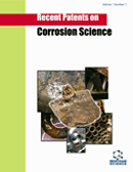Abstract
If not properly managed, microbially influenced corrosion (MIC) may have significant economic, safety, health, or environmental consequences for a wide range of industries. Microbes can actively participate in the corrosion processes and affect their thermodynamics and kinetics; interfere in the electrochemical reactions at the anode, at the cathode, or both; and alter the metal/solution interface and the redox potential of the substratum via a host of often interrelated mechanisms. Over the last two to three decades, significant advancements have been made to improve the understanding of dynamic interactions between microbes and metallic surfaces. This paper presents the current understanding of MIC, followed by a synthesis of various recent patents, patent applications and publications related to the mitigation of MIC. The 15 inventions reviewed concern a period extending from the years 2002 up to date. The paper concludes with a discussion of future developments expected in the subjects covered.
Keywords: Microbially Influenced Corrosion, biofilm, biocide, superhydrophobic surface, anti-corrosion coatings, corrosion inhibition, microbial induced corrosion, non-metallic pipelines, metallic pipelines, microbial nanowires, corrosion protection, antibacterial resin, Microencapsulation, marine biofilm, biocorrosion
 9
9

